
A | B | C | D | E | F | G | H | CH | I | J | K | L | M | N | O | P | Q | R | S | T | U | V | W | X | Y | Z | 0 | 1 | 2 | 3 | 4 | 5 | 6 | 7 | 8 | 9
It has been suggested that this article should be split into a new article titled Benghazi District. (discuss) (December 2023) |
This article needs to be updated. (October 2015) |
Benghazi
بنغازي | |
|---|---|
 Benghazi seafront | |
| Nickname: رَبّايِةْ الْذَايِحْ (Mother of Migrants) – الْمَدِينََه الْعَصِيّهْ (The Intractable City) | |
| Coordinates: 32°07′N 20°04′E / 32.117°N 20.067°E | |
| Country | |
| Region | Cyrenaica |
| District | Benghazi |
| Settled | as Euesperides (circa 525 BC) |
| Renamed | • Berenice (circa middle of the 3rd century BC) • Hesperides[clarification needed] • Barneeq (circa middle of the 7th century AD) • Marsa ibn Ghazi (circa 16th century) • Bani Ghazi[clarification needed] • Benghazi[clarification needed] |
| Government | |
| • Mayor | Saqr Bojwari |
| Area | |
| • City | 314 km2 (121 sq mi) |
| Elevation | 2 m (7 ft) |
| Population (2020)[2] | |
| • City | 1,207,250 |
| • Density | 3,800/km2 (10,000/sq mi) |
| • Metro | 1,500,000 |
| Demonym | Benghazian |
| Time zone | UTC+2 (EET) |
| Area code | (+218) 61 |
| License Plate Code | 8 |
Benghazi (/bɛnˈɡɑːzi/)[3][4][5][note 1] (lit. Son of Ghazi) is the second-most-populous city in Libya as well as the largest city in Cyrenaica, with an estimated population of 1,207,250 in 2020.[2] Located on the Gulf of Sidra in the Mediterranean, Benghazi is also a major seaport.
A Greek colony named Euesperides had existed in the area from around 525 BC. In the 3rd century BC, it was relocated and refounded as the Ptolemaic city of Berenice. Berenice prospered under the Romans, and after the 3rd century AD it superseded Cyrene and Barca as the centre of Cyrenaica. The city went into decline during the Byzantine period and had already been reduced to a small town before its conquest by the Arabs. After around four centuries of peaceful Ottoman rule, in 1911, Italy captured Benghazi and the rest of Tripolitania from the Ottoman Empire. Under Italian rule, Benghazi witnessed a period of extensive development and modernization, particularly in the second half of the 1930s under the Italian Libya colony. The city changed hands several times during World War II and was heavily damaged in the process. After the war Benghazi was rebuilt and became the co-capital of the newly independent Kingdom of Libya. Following the 1969 coup d'état by Muammar Gaddafi, Benghazi lost its capital status and all government offices relocated to Tripoli.
On 15 February 2011,[14] an uprising against the government of Muammar Gaddafi occurred in the city.[15] The revolts spread by 17 February to Bayda, Tobruk, Ajdabya, Al Marj in the East and Zintan, Zawiya in the West, calling for the end of the Gaddafi regime. Benghazi was seized by Gaddafi opponents on 21 February, who founded the National Transitional Council.[16] On 19 March 2011, the city was the site of the turning point of the Libyan Civil War, when the Libyan Army attempted to score a decisive victory against the NTC by attacking Benghazi, but was forced back by local resistance and intervention from the French Air Force authorized by UNSC Resolution 1973 to protect civilians, allowing the rebellion to continue. By 2014, a second civil war broke out in Libya between the House of Representatives and the Government of National Accord, with parts of Libya split between Tobruk and Tripoli based governance until a permanent ceasefire led by a unitary government in 2020.[17]
Benghazi remains a centre of Libyan commerce, industry, transport and culture, and one of the three largest cities in Libya with Tripoli and Misrata. It continues to hold institutions and organizations normally associated with a capital city, including several national government buildings as well as the National Library of Libya.
History
Ancient Greek colony

Archaeological evidence shows that ancient Greeks settled on the site of Benghazi in the late seventh century BC.[18] They called the city Euesperides (Ancient Greek: Εὐεσπερίδες)[19] and Hesperis (Ancient Greek: Ἑσπερίς).[20] Euesperides was most likely founded by people from Cyrene or Barce, which was located on the edge of a lagoon which opened from the sea. At the time, this area may have been deep enough to receive small sailing vessels. The name was attributed to the fertility of the neighborhood, which gave rise to the mythological associations of the garden of the Hesperides.[21] The ancient city existed on a raised piece of land opposite of what is now the Sidi-Abayd graveyard in the Northern Benghazi suburb of Sbikhat al-Salmani (al-Salmani Marsh).
The city is first mentioned by ancient sources in Herodotus' account of the revolt of Barca and the Persian expedition to Cyrenaica in c. 515 BC, where it is stated that the punitive force sent by the satrap of Egypt conquered Cyrenaica as far west as Euesperides.[22] The oldest coins minted in the city date back to 480 BC. One side of those coins has an engraving of Delphi. The other side is an engraving of a silphium plant, once the symbol of trade from Cyrenaica because of its use as a rich seasoning and as a medicine. The coinage suggests that the city must have enjoyed some autonomy from Cyrene in the early 5th century BC, when the issues of Euesperides had their own types with the legend EU (ES), distinct from those of Cyrene.
The city was in hostile territory and was surrounded by inhospitable tribes. The Greek historian Thucydides mentions a siege of the city in 414 BC, by Libyans who were probably the Nasamones: Euesperides was saved by the unexpected arrival of the Spartan general Gylippus and his fleet, who were blown to Libya by contrary winds on their way to Sicily.[23]
One of the Cyrenean kings whose fate is connected with the city is Arcesilaus IV. The king used his chariot victory at the Pythian Games of 462 BC to attract new settlers to Euesperides, where Arcesilaus hoped to create a safe refuge for himself against the resentment of the people of Cyrene. This proved ineffective, since when the king fled to Euesperides during the anticipated revolution (around 440 BC), he was assassinated, thus terminating the almost 200-year rule of the Battiad dynasty.
An inscription found there and dated around the middle of the 4th century BC states that the city had a constitution similar to that of Cyrene, with a board of chief magistrates (ephors) and a council of elders (gerontes). From 324 to 322 BC, the city supported the Spartan adventurer Thibron, who attempted to establish his own kingdom in Cyrenaica, but was defeated.[24] The city came under the control of Ptolemy I and formed part of the breakaway kingdom of Magas of Cyrene after 276 BC.[25]
In 246 BC, during the power struggle following Magas' death, his daughter Berenice married Ptolemy III, bringing the region back under Ptolemaic control. Euesperides was relocated to a new site underneath Benghazi's modern city centre and renamed Berenice. The move may have been due to the silting up of the lagoons, but there is no archaeological evidence for economic decline in the preceding period, and it is more likely that the refoundation was punishment for having opposed Berenice and Ptolemy's assumption of power.[26][27]
Roman Era
Modern Benghazi, on the Gulf of Sidra, lies a little southwest of the site of the ancient Greek city of Berenice or Berenicis or Bernici. That city was traditionally founded in 446 BC (different sources give different dates like 347 BC[28] or 249 BC[29]), by a brother of the king of Cyrene, but got the name Berenice only when it was refounded in the 3rd century BC under the patronage of Berenice (Berenike), the daughter of Magas, king of Cyrene, and wife of Ptolemy III Euergetes, the ruler of Egypt. The new city was later given the name Hesperides, in reference to the Hesperides, the guardians of the mythic western paradise. The name may have also referred to green oases in low-lying areas in the nearby coastal plain.
Benghazi later became a Roman city and greatly prospered for 600 years. The city superseded Cyrene and Barca as the chief center of Cyrenaica after the 3rd century AD[30] and during the Persian attacks; in 642–643 -when was conquered by the Arabs and partially destroyed- it had dwindled to an insignificant village among magnificent historic ruins.[citation needed]
In its more prosperous period, Berenice became a Christian bishopric. The first of its bishops whose name is recorded in extant documents is Ammon, to whom Dionysius of Alexandria wrote in about 260. Dathes was at the First Council of Nicaea in 325, and Probatius at a synod held in Constantinople in 394.[31][32] No longer a residential bishopric, Berenice is today listed by the Catholic Church as a titular see.[33]

Ottoman province
In the 13th century, the small settlement became an important player in the trade growing up between Genoese merchants and the tribes of the hinterland. In 16th century maps, the name of Marsa ibn Ghazi appears.[clarification needed]
Benghazi had a strategic port location, one that was too useful to be ignored by the Ottomans. In 1578, the Turks conquered Benghazi and it was ruled from Tripoli by the Karamanlis from 1711 to 1835; it then passed under direct Ottoman rule until 1911. Greek and Italian sponge fishermen worked its coastal waters. In 1858, and again in 1874, Benghazi was devastated by bubonic plague.
Italian colonial rule
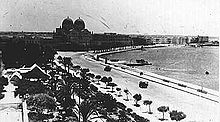

In 1911, Benghazi was invaded and conquered by the Italians. Nearly half the local population of Cyrenaica under the leadership of Omar Mukhtar resisted the Italian occupation.[34]
In the early 1930s, the revolt was over and the Italians—under governor Italo Balbo—started attempts to assimilate the local population with pacifying policies: a number of new villages for Cyrenaicans were created with health services and schools.
Additionally Cyrenaica was populated by more than 20,000 Italian colonists in the late 1930s, mainly around the coast of Benghazi. Benghazi population was made up of more than 35 per cent of Italians in 1939.[citation needed] As a consequence, there was in Cyrenaica and mostly in Benghazi a huge economic development in the second half of the 1930s. Benghazi grew to be a modern city with a new airport, new railway station, new seaplane station, an enlarged port and many facilities. Benghazi was going to be connected in 1940 by a new railway to Tripoli, but in summer of that year war started between Italians and British and infrastructure development came to a standstill.
World War II
In World War II Benghazi changed hands several times. During Operation Compass the city was captured from the Italians by Combe Force on 6 February 1941.
Benghazi was recaptured by Axis powers, led by general Erwin Rommel of the German Africa Corps, on 4 April.[35]
It was taken again during Operation Crusader by the British on 24 December only to change hands again on 29 January 1942 in the Rommel Afrika Corps' push to Egypt.
During the fateful Battle of El Alamein–106 kilometres (66 miles) from Alexandria, Egypt–British troops led by general Bernard Montgomery again defeated the Afrika Corps which then made a long steady retreat westward passing through Benghazi for the final time. On 20 November, Benghazi was captured by the British Eighth Army and thereafter held by the British.
In August 1943 from Benina airport of Benghazi started the US attack on the Ploiești oil refineries with 178 B-24 bombers (called Operation Tidal Wave), after an Italian "Arditi" paratroopers attack that destroyed some Allied aircraft in June 1943.[citation needed]
Contemporary Benghazi
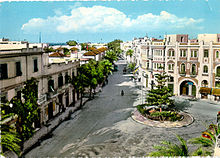
Heavily bombed in World War II, Benghazi was later rebuilt with the country's newly found oil wealth as a gleaming showpiece of modern Libya. It became the capital city of Emirate of Cyrenaica (1949–1951) under Idris Senussi I. In 1951, Cyrenaica was merged with Tripolitania and Fezzan to form the independent Kingdom of Libya, of which both Benghazi and Tripoli were capital cities.

Benghazi lost its capital status when the Free Officers under the leadership of Muammar Gaddafi staged a coup d'état in 1969, whereafter all government institutions were concentrated in Tripoli, Even though King Idris was forced into exile and the monarchy abolished, support for the Senussi dynasty remained strong in Cyrenaica. This was emphasized by real or perceived injustices from the government towards the people of Benghazi, including the demolition in the year 2000 of the arena of football club Alahly Benghazi S.C., following anti-government protests.[36][37] On 15 April 1986, U.S. Air Force and Navy planes bombed Benghazi and Tripoli. President Ronald Reagan justified the attacks by claiming Libya was responsible for terrorism directed at the United States, including the bombing of La Belle discothèque in West Berlin ten days before.[citation needed]
2011 Revolution

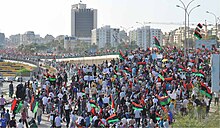
In February 2011, peaceful protests erupted in Benghazi that were brutally suppressed by Gaddafi's armed forces and loyalists. The violence urged the people to fight back and try to overthrow Gaddafi from power in The Libyan Revolution. At least 500 people were killed in the protests against the government.[38]

The former Libyan flag used in the Kingdom of Libya was used by many protesters as an opposition flag.[40][41] Demonstrators were also seen carrying images of King Idris I. Benghazi and the Cyrenaica have been traditional strongholds of the royal Senussi dynasty.[42]
By 21 February, the city was reported to be largely controlled by the opposition. The widely loathed mayor, Huda Ben Amer, nicknamed "the Executioner", had fled the city for Tripoli.[43] Residents organised to direct traffic and collect refuse.[16] By 24 February, a committee made up of lawyers, judges and respected local people had been formed in order to provide civic administration and public services within the city. Two local radio stations, operated by Voice of Free Libya, along with a newspaper, were also established.[16][44]
From 26 February to 26 August, Benghazi was the temporary headquarters of the National Transitional Council which is led by the former justice minister, Mustafa Abdul Jalil, until Tripoli was liberated.[45]
On 19 March, pro-Gaddafi forces almost defeated the rebellion when they began attacking the city of Benghazi in a major offensive, but were forced back the next day when NATO forces began implementing United Nations Security Council Resolution 1973.[46]
On 1 June, explosives were detonated in a car near the Tibesti Hotel,[47] with a rebel spokesman calling the bombing a "cowardly act". It was suspected that an officer was killed, and many people started to shout out anti-Gaddafi chants while the Tibesti was cordoned off.[citation needed]
On 19 May 2012, residents of Benghazi voted in historic local elections; this was the first time such elections have been held in the city since the 1960s, and turnout was high.
2012 attack on U.S. diplomatic mission
On 11 September 2012, the U.S. diplomatic mission in Benghazi was attacked by a heavily armed group of 125–150 gunmen, whose trucks bore the logo of Ansar al-Sharia, a group of Islamist militants, also known as Al Qaeda in the Arabian Peninsula,[48] working with the local government to manage security in Benghazi.[49] U.S. Ambassador J. Christopher Stevens, Foreign Service Information Management Officer (IMO) Sean Smith, and CIA contractors and former Navy SEALs Tyrone S. Woods and Glen Doherty were killed during a series of raids, commencing at nightfall and continuing into the next morning. Ten others were injured.
Second Libyan Civil War
Following the outbreak of the second Libyan Civil War in 2014, Benghazi became the subject of heavy fighting between the Libyan National Army-aligned House of Representatives government, and the Islamist Shura Council of Benghazi Revolutionaries and ISIL-aligned Wilayat Barqa, which were entrenched in various pockets in the city. During the closing months of the battle, between late-2016 and mid-2017, much of the urban center in and around the remaining Shura Council pocket in the central coastal quarters of Suq Al-Hout and al-Sabri suffered heavy bombardment and war damage. Wilayat Barqa militants reportedly fled Benghazi in early January, while the LNA's General Khalifa Haftar declared the city cleared of the Shura Council on 5 July 2017.[50] Despite Haftar's declaration of the liberation of the city, dozens of gunmen remained fortified and besieged in Sidi Akribesh, according to sources close to military.[51] LNA captured the last militant-held district in December 2017.[52]
On 23 October 2020, the 5+5 Joint Libyan Military Commission representing the LNA and the GNA reached a "permanent ceasefire agreement in all areas of Libya". The agreement, effective immediately, required that all foreign fighters leave Libya within three months while a joint police force would patrol disputed areas. The first commercial flight between Tripoli and Benghazi took place that same day.[53][54] On 10 March 2021, an interim unity government was formed, which was slated to remain in place until the next Libyan presidential election scheduled for 10 December.[55] However, the election has been delayed several times[56][57][58] since, effectively rendering the unity government in power indefinitely, causing tensions which threaten to reignite the war.
Administrative divisions
Benghazi District is one of Libya's 22 shabiyahs (people's districts).
In 2022, 18 provinces were declared by the Libyan Government of National Unity: the eastern coast, Jabal Al-Akhdar, Al-Hizam, Benghazi, Al-Wahat, Al-Kufra, Al-Khaleej, Al-Margab, Tripoli, Al-Jafara, Al-Zawiya, West Coast, Gheryan, Zintan, Nalut, Sabha, Al-Wadi, and Murzuq Basin.[59]

Benghazi Baladiyah is divided into 32 Basic People's Congress administrative divisions, in which the responsibilities of the corresponding political units of the same name fall. The official 32 Basic People's Congresses of Benghazi are:[60]
|
|
|
|
Population
Demographics
This article needs additional citations for verification. (September 2011) |
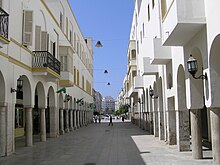
As with other cities in Libya, there is a reasonable amount of ethnic diversity in Benghazi. The people of eastern Libya, Benghazi included, have in the past always been of predominantly Arab descent. In recent times, however, there has been an influx of African immigrants into Benghazi. There are also many Egyptian immigrants in Benghazi. A small Greek community also exists in Benghazi. The Greek island of Crete is a short distance from Benghazi, and many families in Benghazi today bear Cretan surnames. There are even a few Italian-related families, left from the colonial times before World War II.
The overwhelming majority of Libyans in Benghazi were of Berber descent until the arrival of Bani Salim (Arabic tribe). In the 11th century, the Sa'adi tribes from the Banu Sulyam migrated to Cyrenaica; each sub-tribe from the Sa'adi historically controlled a section of Cyrenaica. Benghazi and its surrounding areas were controlled by Barghathi tribe. In modern times, Benghazi has seen a lot of Libyans from different parts of the country move into the city, especially since the Kingdom era. Many came to Benghazi from Misrata. Thus Benghazi has always been seen as a welcoming city, a city which the local Bedouins refer to as 'Benghazi rabayit al thayih' which can be translated as, 'Benghazi raises the lost', as many immigrants who arrived from the Western Maghreb or the former Al Andalus came with little money, clothes or food and were looked after very generously by the local Bedouin population as well as those arriving following the Italian war from western Libya.
Religion

The predominant religion in Benghazi is Islam. Almost all of the city's inhabitants are Sunni Muslims. During Islamic holidays such as Ramadan, most abstain from food; restaurants are usually empty during the day, with the exception of some expatriates and tourists. Alcohol is banned by law in Benghazi and throughout Libya in accordance with government regulations. The often conservative nature of Benghazi creates a strong sense of family life in the city; most teenagers and young adults live at home until they get married, though that is changing in recent years. Many Muslims in Benghazi adhere to the traditional Maliki school of religious law; however, it is much less so than in the past decades. Benghazi is said to be the most “liberal” city out of all Libya.[61] The Senussi order from which the royal dynasty sprang has traditionally enjoyed strong support in Benghazi and the Cyrenaica.
For Muslims, there are many mosques throughout Benghazi; the oldest and best known (such as the Atiq and Osman mosques) are located in and around the medina.
There is also a small Christian community in the city. The Roman Catholic Apostolic Vicariate of Benghazi's Franciscan Church of the Immaculate Conception serves Benghazi's Latin Catholic community of roughly 4,000; there is also a decommissioned cathedral church (1929–1939; closed 1977; currently abandoned). For Egyptian Copts, there is a Coptic Orthodox church (which was formerly the grand synagogue) with two serving priests.[62]
Jews have lived in Benghazi, as they did elsewhere in Libya, from Roman times until 1967 when most were airlifted out after a series of riots in the years after the 1948 Arab–Israeli War. However, there are no Jews remaining in Libya today.[63]
Education

The oldest university in Libya is the University of Libya, founded by royal decree in 1955. It was initially housed in the royal Al Manar Palace before receiving its own campus in 1968. It was later split and became known as University of Benghazi.[64] There are some private universities such as Libyan International Medical University.[65]
Education in Benghazi, as throughout Libya, is compulsory and paid entirely by taxpayers. Compulsory education continues until ninth grade. There are many public primary and secondary schools scattered throughout the city, as well as some private schools.[66]
International schools include:
Geography
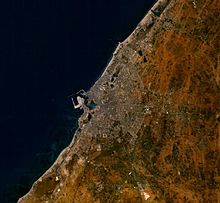
Benghazi is one of the sub-regions of the area referred to as Cyrenaica, the others being the Jebel Akhdar and the coastal plain running east of Apollonia. Cyrenaica is surrounded by desert on three sides, hence in ancient times the most accessible civilisation was to the North, across the Mediterranean, in Crete and Greece, only 400 kilometres (250 miles) away.[67]
Benghazi is surrounded by the "barr", arid steppe. The Jebel Akhdar, literally, "the Green Mountain", just north of Benghazi, rises to the east. Here the vegetation and climate is more Mediterranean in feel with none of the desert landscapes found further south. A large section of the western Jebel Akhdar is taken up by the fertile Marj plain. Further east is the second level of the Jebel Akhdar, between 500 metres (1,600 feet) and over 875 m (2,871 ft) above sea level, often thickly wooded and cut by ravines. Annual rainfall here, especially around Cyrene, can reach 500 millimetres (20 inches). It was this fertile site northeast of Benghazi that the Greeks chose for their settlement. The soil in Benghazi is a rich red colour and very clayey. Sirocco winds are not uncommon in the city, and as such, many of Benghazi's smaller streets and buildings can be quite dusty.[68]
To the north, below the steep cliffs of the plateau, lies a narrow belt of Mediterranean farmland. Olives and other Mediterranean fruits and vegetables are grown here. To the south, the forest and farmland gives way to juniper bush maquis and pre-desert scrub with some winter grazing.[citation needed]
As a district, Benghazi borders Hizam Al Akhdar, which surrounds it on land.
Natural recreation and parks
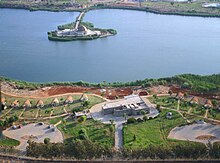
Although Benghazi does not have a high percentage of green space per resident, there are a few public parks and green recreational areas in the city. Perhaps the most famous is the zoological garden and theme park in Al-Fuwayhat also known as Benghazi Zoo; the park is referred to locally as al-Bosco, an Italian name for wood (as in "Belleau Wood", not as in "wood plank"). The park is a combination of a zoo with trees planted during Italian rule and which contains wild cats, primates, elephants, birds and other animals, and a small theme park containing electrical rides, added later in the 1980s as part of a redevelopment of the entire site. It is one of the most popular parks in Benghazi, and is very busy on public holidays, as well as amongst school children and scouts on outings.
On Gamal Abdel Nasser Street is 23 July Park, another large green space which faces the Tibesti Hotel and borders the waterfront. The park is popular amongst teenagers, and families on Thursday nights (as Friday is a day off work throughout Libya). Another large and popular park is al-Buduzira in North Benghazi on the al-'Uruba Road in al-Kwayfiya. The park surrounds a natural lake, and is more rugged in nature than the city parks. A section of al-Buduzira is also a water park with large slides, whilst the southern part of the park has picnic areas which are popular in the summers.
Climate
Benghazi has a warm semi-arid climate (Köppen climate classification BSh) with hot and dry, prolonged summers and mild to cool, slightly wet winters. In the north of the city lies the Mediterranean-climate 'Jabal Al-Akhdar' (Green Mountains), and in the south the climate is becoming desert-like. Summers in Benghazi are hot and rainless, but with high levels of humidity. Winters are mild with occasional rain. Annual rainfall is low at 270 mm (11 in) per year. The city's local water supply is supplemented by groundwater transported from the aquifers of southern Libya along the Great Manmade River.
| Climate data for Benghazi (Benina International Airport) (1991–2020) | |||||||||||||
|---|---|---|---|---|---|---|---|---|---|---|---|---|---|
| Month | Jan | Feb | Mar | Apr | May | Jun | Jul | Aug | Sep | Oct | Nov | Dec | Year |
| Record high °C (°F) | 26.3 (79.3) |
31.7 (89.1) |
38.0 (100.4) |
39.9 (103.8) |
44.8 (112.6) |
45.6 (114.1) |
43.0 (109.4) |
44.0 (111.2) |
42.1 (107.8) |
39.0 (102.2) |
37.2 (99.0) |
31.0 (87.8) |
45.6 (114.1) |
| Mean daily maximum °C (°F) | 16.6 (61.9) |
17.0 (62.6) |
20.5 (68.9) |
24.4 (75.9) |
28.3 (82.9) |
31.0 (87.8) |
31.4 (88.5) |
32.0 (89.6) |
31.1 (88.0) |
28.0 (82.4) |
22.9 (73.2) |
18.3 (64.9) |
25.1 (77.2) |
| Daily mean °C (°F) | 12.9 (55.2) |
13.0 (55.4) |
15.5 (59.9) |
18.9 (66.0) |
22.7 (72.9) |
25.5 (77.9) |
26.5 (79.7) |
27.1 (80.8) |
26.1 (79.0) |
23.1 (73.6) |
18.5 (65.3) |
14.6 (58.3) |
20.4 (68.7) |
| Mean daily minimum °C (°F) | 9.2 (48.6) |
9.0 (48.2) |
10.5 (50.9) |
13.5 (56.3) |
17.1 (62.8) |
20.1 (68.2) |
21.6 (70.9) |
22.3 (72.1) |
21.1 (70.0) |
18.3 (64.9) |
14.2 (57.6) |
10.9 (51.6) |
15.6 (60.1) |
| Record low °C (°F) | −2.7 (27.1) |
−2.7 (27.1) |
−2.7 (27.1) |
3.9 (39.0) |
6.1 (43.0) |
10.0 (50.0) |
14.8 (58.6) |
14.4 (57.9) |
10.0 (50.0) |
10.8 (51.4) |
5.6 (42.1) |
−3.0 (26.6) |
−3.0 (26.6) |
| Average precipitation mm (inches) | 62.4 (2.46) |
47.3 (1.86) |
25.9 (1.02) |
4.8 (0.19) |
2.9 (0.11) |
0.3 (0.01) |
0.0 (0.0) |
0.3 (0.01) |
4.1 (0.16) |
16.0 (0.63) |
31.3 (1.23) |
69.3 (2.73) |
264.6 (10.42) |
| Average precipitation days (≥ 1.0 mm) | 8.9 | 7.5 | 3.7 | 1.3 | 0.8 | 0.1 | 0.0 | 0.3 | 0.9 | 2.5 | 4.8 | 9.7 | 40.5 |
| Average relative humidity (%) | 73.7 | 71.7 | 64.4 | 56.2 | 53.8 | 56.4 | 64.5 | 65.6 | 62.1 | 63.4 | 66.1 | 71.7 | 64.1 |
| Average dew point °C (°F) | 7.8 (46.0) |
7.3 (45.1) |
7.6 (45.7) |
8.3 (46.9) |
10.9 (51.6) |
14.5 (58.1) |
18.4 (65.1) |
19.3 (66.7) |
17.0 (62.6) |
14.4 (57.9) |
11.0 (51.8) |
8.8 (47.8) |
12.1 (53.8) |
| Mean monthly sunshine hours | 201.5 | 220.4 | 244.9 | 264.0 | 325.5 | 336.0 | 390.6 | 365.8 | 291.0 | 248.0 | 222.0 | 170.5 | 3,280.2 |
| Mean daily sunshine hours | 6.5 | 7.8 | 7.9 | 8.8 | 10.5 | 11.2
Zdroj:https://en.wikipedia.org?pojem=Bengazi Text je dostupný za podmienok Creative Commons Attribution/Share-Alike License 3.0 Unported; prípadne za ďalších podmienok. Podrobnejšie informácie nájdete na stránke Podmienky použitia.
Analytika
Antropológia Aplikované vedy Bibliometria Dejiny vedy Encyklopédie Filozofia vedy Forenzné vedy Humanitné vedy Knižničná veda Kryogenika Kryptológia Kulturológia Literárna veda Medzidisciplinárne oblasti Metódy kvantitatívnej analýzy Metavedy Metodika Text je dostupný za podmienok Creative
Commons Attribution/Share-Alike License 3.0 Unported; prípadne za ďalších
podmienok. www.astronomia.sk | www.biologia.sk | www.botanika.sk | www.dejiny.sk | www.economy.sk | www.elektrotechnika.sk | www.estetika.sk | www.farmakologia.sk | www.filozofia.sk | Fyzika | www.futurologia.sk | www.genetika.sk | www.chemia.sk | www.lingvistika.sk | www.politologia.sk | www.psychologia.sk | www.sexuologia.sk | www.sociologia.sk | www.veda.sk I www.zoologia.sk | |||||||



